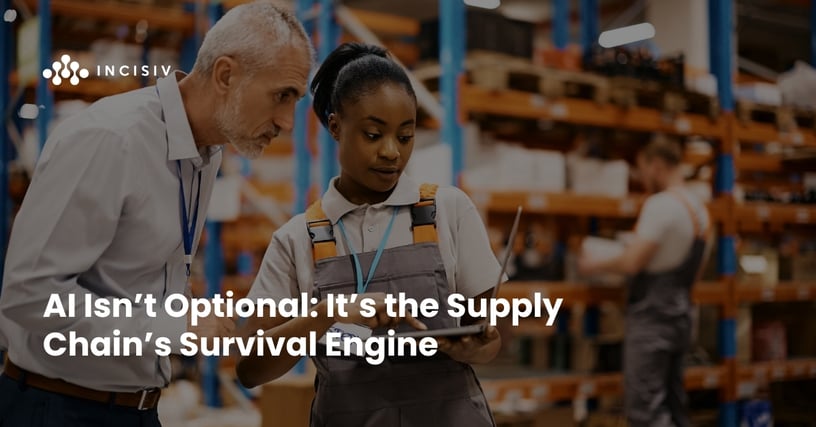Modern supply chains must evolve from reactive to resilient, powered by AI that enables prediction, orchestration, and continuous adaptation.

Why Supply Chains Are Still Failing Under Pressure: The Reactivity Problem
From port congestion and geopolitical risk to raw material volatility and shifting consumer demand, disruptions are constant. Yet most supply chains remain woefully reactive. They operate in silos, lack real-time insight, and scramble to respond after the damage is done.
According to Everest Group, About 68% of enterprises that embarked upon digital transformation have not realized the envisioned outcomes.
Resilience isn’t built on reacting faster. It’s built on preparing smarter—and AI is the core capability that makes this shift possible.
The Real Roadblock: Outdated Architecture That Can’t Keep Up
Most supply chain technologies were not designed for speed, scale, or synchronization. What’s holding them back?
- Disconnected systems – Procurement, inventory, logistics, and demand planning often operate on separate platforms with limited interoperability.
- Data latency and fragmentation – Legacy systems collect data in batches, not streams. Real-time decision-making is impossible without unified, always-on data flows.
- Manual escalation models – Disruption responses often rely on people escalating issues through email or Excel. When timing is everything, delays in communication equal losses.
Until organizations modernize their supply chain architecture to support AI-driven decisions, their ability to withstand and adapt to disruption will remain limited.
The AI-Driven Framework for Resilient Supply Chains: Four Layers of Intelligence
To transition from reactive to resilient, organizations must adopt a purpose-built AI framework designed for sensing, simulating, orchestrating, and learning.
1. Signal Detection and Synchronization: Sensing Before It’s Too Late
Supply chains can’t respond to what they can’t see. The first step toward resilience is early detection—powered by unified, real-time data from every node.
- Real-time intake of structured and unstructured data - AI pulls continuous signals from POS, ERP, warehouse systems, IoT sensors, weather APIs, social sentiment, and news reports. It identifies anomalies—like surging demand, supplier slowdowns, or political unrest—long before traditional systems would.
- Harmonization of demand and supply data - AI synchronizes forecasts and actuals across procurement, merchandising, fulfillment, and finance, ensuring consistent visibility. It closes the gap between what’s expected and what’s happening on the ground.
- Unified view across tiers - Instead of monitoring just Tier 1 suppliers or DCs, AI maps upstream and downstream dependencies, giving supply chain leaders visibility into risks buried two or three layers deep. This tiered visibility is key to avoiding cascading failures.
2. Predictive Decisioning: Simulating the Best Next Step
Once the signals are sensed, the next step is to simulate the possible futures—and choose the right path.
- Simulation modeling
AI stress-tests multiple disruption scenarios—port closures, raw material shortages, labor strikes—and simulates operational, financial, and service-level impact in seconds. Leaders can then compare trade-offs and act preemptively. - Dynamic inventory forecasting
Unlike static models, AI continuously re-forecasts based on real-time demand, event triggers (e.g., promotions, holidays), and regional behavior shifts. Forecasts are automatically adjusted at the SKU, store, or DC level. - Scenario scoring
Each potential response is scored based on KPIs like margin impact, lead time, customer SLA risk, and fulfillment feasibility. AI then recommends the highest-value action—enabling human teams to move from firefighting to fine-tuning.
3. Autonomous Orchestration: Acting Without Waiting
Speed matters. Once a decision is made, AI enables rapid, coordinated execution—across channels, systems, and partners.
- Intelligent routing
AI reprioritizes order routing in real-time—based on inventory health, cost-to-serve, weather disruptions, or labor availability—ensuring the most efficient fulfillment path is used, every time. - Supplier decisioning
When suppliers can’t deliver, AI autonomously selects alternates based on past performance, cost, and risk profile. It can issue RFQs, initiate reorders, or activate substitute SKUs to maintain availability. - Workflow automation
AI integrates with OMS, WMS, and CRM platforms to launch alerts, adjust delivery dates, notify customers, and trigger promotional changes—without the need for manual intervention or approvals.
4. Continuous Learning: Getting Smarter with Every Disruption
Resilient supply chains aren’t static—they evolve. AI systems learn from every event, improving accuracy and response with each cycle.
- Post-event analysis
After a disruption, AI runs diagnostics to identify what triggered delays, which decisions worked, and where the gaps were. This closes the loop on decision quality and provides transparency for internal teams. - Behavioral learning
AI recognizes recurring disruption patterns (e.g., seasonal storms, supplier bottlenecks) and begins adjusting forecasts and buffers automatically. This institutional memory builds long-term resilience. - Self-improving models
Using machine learning and reinforcement learning, AI updates algorithms and decision rules based on outcomes—without human tuning. The system evolves, offering smarter recommendations the more it operates.
The Business Benefits of AI-Powered Resilience: More Than Just Risk Reduction
Resilience isn't just a defensive posture—it delivers measurable, strategic gains:
- Reduced cost of disruption – AI-powered detection and orchestration can cut disruption costs by up to 25% through early action and better planning.
- Faster response times – what once took hours or days (rerouting, reordering, rebalancing) now happens in minutes through autonomous orchestration.
- Stronger service levels and brand trust – customers stay loyal when retailers consistently deliver, even during high-stress periods.
Why It Matters Ahead of NRF 2026: A Wake-Up Call for the Industry
At NRF 2026, the spotlight will be on those who didn’t just digitize their supply chains—but made them intelligent, adaptive, and future-ready.
Leaders are focused on:
- Composable architecture – to plug in new capabilities as business conditions evolve
- Unified data clouds – to break down silos and drive decisions based on a single, real-time view
- AI at the decision layer – embedded into planning, execution, and risk management processes across the network
According to MHI, only 12% of supply chain professionals currently use AI, but 60% expect to within five years. That shift is already underway—and NRF 2026 will separate those who started from those who stalled.
Takeaway: Resilient Supply Chains Think Ahead
Efficiency alone is no longer enough. The future belongs to supply chains that can see what’s coming and act with speed and intelligence.
AI helps businesses stay ahead by detecting risks early, predicting outcomes, and coordinating fast, effective responses.
If your supply chain can’t learn and adapt, it won’t keep up. It’s time to make resilience a built-in advantage.





